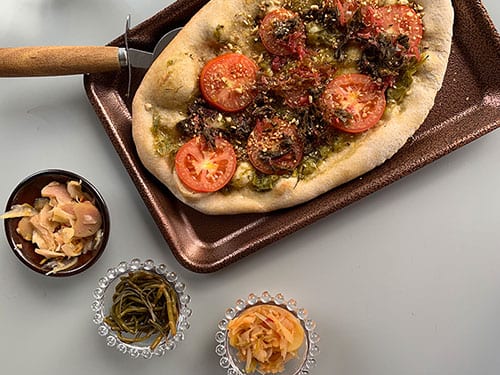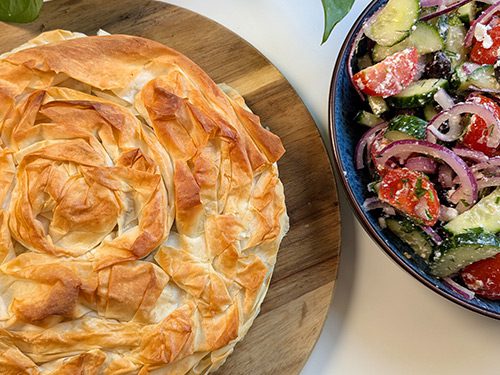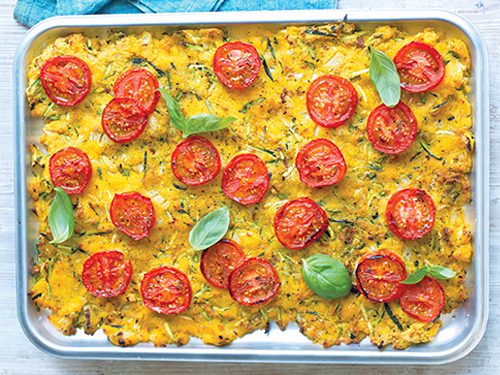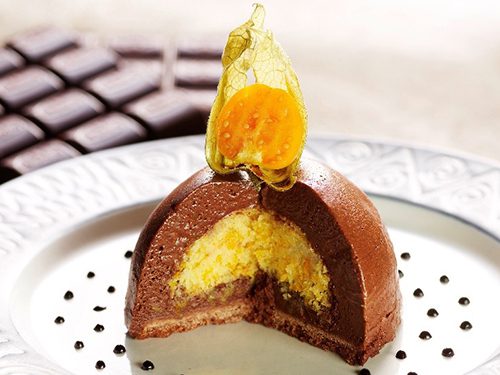Heritage Tomato, Kale Kraut and Cashew Crumb Pizza
Share the love
- Serves: Makes 4 delicious vegan pizzas
- Preparation: 120
- Cooking: 5
- Passive: 120
- Ready: 245

A pizza with a real ‘wow’ factor – your efforts will be rewarded!
Ingredients
For the bases
- 550 g organic stone ground flour
- 330 ml filtered water
- 1 teaspoon organic active dried yeast (or 1/2 teaspoon if you are leaving the dough overnight)
- 1 tablespoon sea or rock salt
- 4 tablespoon semolina (for the shaping)
For the tomato passata
- 1 x 220 g tin of organic tomatoes
- 1 teaspoon chopped fresh thyme (stalks removed)
- 2 tablespoon of extra virgin olive oil
- pinch of sea salt
- 1 teaspoon of balsamic vinegar
For the kale kraut (this makes a 1L Kilner jar so you’ll have enough for some left over).
- 500 g kale, shredded
- 300 g Chinese cabbage, shredded
- 200 g heritage carrots, shredded
- 1 teaspoon smoked Scottish chilli flakes (we recommend Smoky Brae)
- 1 teaspoon heated mustard seeds
- zest of 1 lemon
- 2 heaped tablespoon of sea salt
For the topping
- 4 x heritage tomatoes, sliced thinly
For the cashew crumb
- 3 tablespoon toasted cashews
- 1 tablespoon toasted sesame seeds
- 2 teaspoon nutritional yeast flakes
- 1/2 teaspoon organic mustard powder
- 1/2 teaspoon organic onion powder
- 1/4 teaspoon dried organic oregano
Method
For the bases
To make a flavoursome pizza dough, weigh out 200 g of organic stoneground wheat flour – we use a mix of E5 Bakehouse and Gilchester’s Organic flours at Flat Earth. Add 200 ml of filtered water at 38°C along with the organic active dried yeast.
Mix thoroughly to a stiff batter using a silicone spatula or whisk. Once mixed thoroughly, cover with a tea towel and let stand for an hour or two in a warm environment whilst the yeast starts its magic.
Come back to the mixture once this has doubled in size and add your choice of sea or rock salt, the rest of the flour and filtered water and work into a dough using your hands or a dough scraper until the dough is fully mixed through.
Turn the dough onto a floured surface and fold the dough 4 or 5 times ensuring it is fully integrated with the salt and remaining flour. This dough can be now put into a lightly oiled bowl, covered and stored in the fridge for up to 2 days gaining flavour as the yeast continues to develop. We recommend putting a light brush of good extra virgin olive oil on the top of the dough before you refrigerate to stop a crust forming.
If you want to use the dough sooner, cut into 4 equal amounts and roll into tight even dough balls and place each one onto a semolina floured tray. Cover and then let prove at room temperature for a further 2 to 3 hours. The dough balls will have a pillowy feel to them when risen sufficiently. Give them a poke with your finger and if the dent remains (and doesn’t spring back) then they are ready to bake.
For the tomato passata
Blend the tomatoes with chopped fresh thyme, extra virgin olive oil, a pinch of salt and a teaspoon of balsamic vinegar.
If the sauce remains quite thick you could add some filtered water to thin, and then refrigerate until required.
For the kale kraut
Mix the shredded kale, Chinese cabbage, heritage carrots, smoked Scottish chilli flakes, lemon zest and mustard seeds in a bowl with your hands.
Layer this mixture with salt in a large bowl. Massage the salt into the kraut for a few minutes, wait 5 mins, then repeat. You’ll notice lots of moisture coming out of the kraut: this is the brine.
Put into a sterilised Kilner jar using a weight to push the kraut down so that the brine covers the leaves.
Leave in a dark place at a cool room temperature (about 18-20°C) for at least 5 days until it’s ready to eat, however, you can experiment with leaving it for longer and tasting at different intervals to see how the fermentation changes the taste of the kale. It’s down to personal preference, max of 4 weeks.
Check the kraut every day, releasing any gases that have built up as it ferments by simply opening the jar and giving the kraut a stir to release the bubbles. You’ll see small bubbles appearing within the kraut and possible on top of the brine.
For the topping
Sprinkle the tomatoes over the pizza.
For the cashew crumb
Pulse the cashews to a coarse crumb in food processor, mix in the rest of the ingredients and season to taste.
This will keep in your pantry for ages in a sealed Kilner jar so can be used on lots of other dishes such as salads and pastas. If you would like a little more kick or Unami you could add 1/2 teaspoon of soy sauce or a pinch of porcini powder to the mix.
For the baking
At home we use a large Le Creuset frying pan to make our pizzas. You can follow our method or cook on a pizza stone in your oven on the hottest setting! Either way both pizzas should be ready in around 5 or 6 minutes.
Put your dry pan onto the hob and turn onto the hottest setting.
Roll the dough out evenly to the size of your pan with your hands or a rolling pin using semolina flour on the worktop to prevent sticking. (1/4 turn the base after each roll).
Place the lightly floured (semolina) base into the hot pan without toppings, heating through for 1 minute.
Evenly spread the organic tomato passata on to the base leaving a small 2cm lip free from sauce and place the heritage tomatoes and kale kraut on top.
Heat the base until it has browned (1 to 2 minutes).
Now place the pan under the grill pre-heated on its hottest setting, heating through the kale and cherry tomatoes and browning the top slightly.
Note: We make a more wholesome and bready pizza at Flat Earth so you will get a different finish to those high street chain wood fired oven pizzas.
Once the pizza has browned sufficiently and you are happy with the finishing of the tomatoes and kale, remove from the heat and transfer the pizza from the pan to a wooden board.
To finish
Add a sprinkle of cashew crumb and drizzle a little extra virgin olive oil around the crust. We sometimes zest a little orange into the oil before service if that takes your fancy.
Cut and serve your wild pizza – enjoy !
Additional notes
Recipe courtesy of Flat Earth Pizza
“At Flat Earth, we don’t necessarily follow a traditional kraut recipe but use a variety of seasonal leaves and kale was the leaf of choice when we made this kraut in summer. The beauty of kraut is that you can add many different types brassica leaves as long as they are preferably organic and you sterilise your Kilner jars. You will also need the patience to let your kraut mature.”
For more pizza inspiration, follow @flatearthpizzas on instagram or visit www.flatearthpizzas.com








